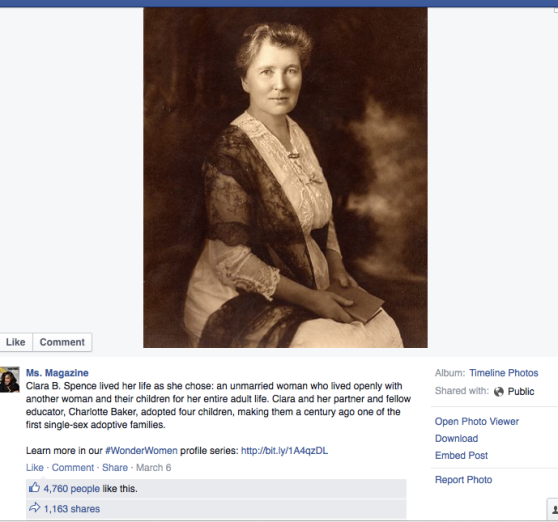http://msmagazine.com/blog/2015/03/06/clara-b-spence-ahead-of-her-time/
Category Archives: Uncategorized
“Frighteningly Adorable”
Clara Beebe Spence is an important, overlooked subject for a biography.
Educator, women’s rights advocate, adoption pioneer and civic leader Clara Spence was a woman ahead of her time. Born into a middle-class family in Albany, New York in 1862, by the time she was thirty she had gotten a degree in oratory from Boston University, gone to London to study Shakespeare, played leading ladies at the Madison Square Theater in New York City, and started the school for girls on East 91st Street in New York City that still bears her name. By the age of fifty, Clara Spence and her partner and fellow educator Charlotte Baker had adopted four children, making them one of the first single-sex adoption families.
Today, The Spence School is ranked #9 by Forbes in the national best prep schools list – it’s still all-women, and notably, over 33 percent of the student body consists of students of color. It has remained true to its founder’s mission: “A place not of mechanical instruction, but a school of character where the common requisites for all have been human feeling, a sense of humor and the spirit of intellectual and moral adventure.” Famous “Spence Girls” include actresses Gwyneth Paltrow and Elizabeth Montgomery, writer Francine du Plessix Gray, philanthropist Marjorie Post, and daughters of the super-rich from Helen Clay Frick and Margaret Carnegie to Georgina Bloomberg. TV viewers have seen The Spence School on “Gossip Girl,” which the producers say was influential in the creation of the show.
But few today, even past and current “Spence Girls,” know how influential and ground-breaking Clara Spence was. She served on many boards (often one of just a handful of women), including Tuskegee Institute, the American Museum of Natural History, Greenwich House, Barnard College, the League for Political Action, (which she founded) the Oratorio Society, the National Endowment for the Arts, and the Metropolitan Museum of Art. She marched with Harriot Stanton Blatch in the suffrage parade down Fifth Avenue in 1913 to promote equal opportunity for women.
Clara Spence hired Isadora Duncan to teach interpretive dance to her students, had her friend Edith Wharton lecture, and invited Helen Keller to talk through her interpreter, Anne Sullivan. When Booker T. Washington came to New York City to raise money for the Tuskegee Institute, he spoke at his friend Clara Spence’s school and stuck around to dine with the girls. The young Aldous and Julius Huxley came to dinner. Ruth Draper, who attended Spence for a year, was Clara’s good friend, and she gave her famed monologues at the school.
Called “frighteningly adorable” by one of her students, Clara Spence was known to kick up her heels and dance the Highland Fling of her native Scotland. At her funeral in 1923, steel magnate Charles Schwab called her a “noble and splendid woman” and admitted that of all the people he had known in industry and on boards, it was Clara Spence whose judgment he valued the most, because her “motive was so whole-souled and unprejudiced.”


